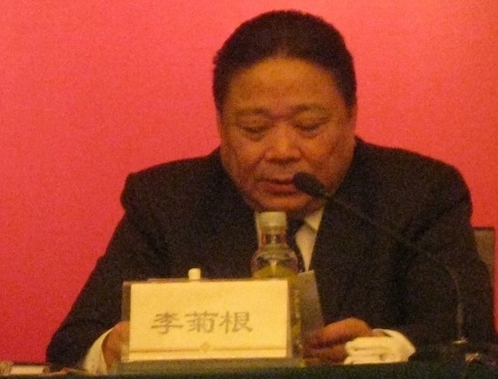By Li Jugen Executive vice chairperson
and general secretary of CSHE

---Honorable vice minister Mr Hu Siyi,
Distinguished guests, ladies and gentlemen,
good morning!
After the meticulous preparation, the
inaugural ceremony of SHP special committee of China Society
of Hydroelectric Engineering is being held here today.
First, I would like to, on behalf of SHP special committee,
to express my congratulations on its establishment. Besides,
I want to extend my heartfelt thanks to Mr. Hu Siyi, vice
minister of the Ministry of Water Resources, who has came
for the ceremony in person and delivered an encouraging
speech, as well as to all the leaders and other participants
for coming all the way for the ceremony. My thanks also
go to the National Research Institute for Rural Electrification
and the organizing committee for their painstaking efforts.
As is known to all, China ranks the
first in the world in water resources.
In China, the theoretical potential water resources amount
reaches 694 million kW with the annual generation of 6080
billion kWh. The technical exploitable amount reaches
542 million kW with the annual generation of 2470 billion
kWh. And the economic exploitable amount reaches 402 million
kW with the annual generation of 1750 billion kWh. Meanwhile,
China is also rich in small hydropower with the potential
small hydropower amount ranking first in the world. According
to the latest survey, the technical exploitation amount
of small hydropower resources reaches 128 million kW and
covers more than 1600 counties in 30 provinces(regions
or cities), 65% and 50% of which can be respectively found
in the western regions and southwest of China, mainly
covering provinces of Hunan, Hubei, Guangdong, Guangxi,
Henan, Zhejiang, Fujian, Jiangxi, Yunnan, Sichuan, Xinjiang
and Tibet. The exploitable small hydropower resources
of those provinces account for about 90% of the whole
country.
China's hydroelectric power generation
starts with the development of small hydropower. China's
first hydropower station Shilongba hydropower station
built in 1912 in Kunming, Yunan province, is categorized
as small hydropower.
Due to constraints including technology,
fund, system and the then productivity, China's small
hydropower development didní»t score remarkable progress
until the end of the 1970s. Prior to reform and opening-up,
the total installed capacity for China's small hydropower
is less than 7 million kW. But after the reform and opening-up,
China's hydropower development enters a stage of fast
growth with the focus of the central government shifted
to economic development. Because of small investment,
short construction period, low risk, good performance,
low operation cost, convenient power supply and favorable
policies of the state, there comes a crave for small hydropower
investment. Especially in the recent years, owing to electricity
shortage and the need to construct the new countryside,
private investment in small hydropower emerges like mushrooms
after rain in spring. The construction speed increases
year by year with the construction scale of more than
5 million kW every year and commissioning scale of over
1 million kW. By the end of 2007, the total installed
capacity for China's hydropower reaches 0.145 billion
kW with an annual generation of 486.7 billion kWh. While
the total installed capacity for small hydropower is around
50 million kW, accounting for 37% of the whole nationwide,
with an annual generation of 150 billion kWh. The number
of small hydropower stations exceeds 45,000. Because of
its wide distribution, its role in basic power supply
is far more significant. Currently, 1/2 of the national
territory, 1/3 of the counties and 1/4 of the population
get access to power through small hydropower. Its function
of decentralized power supply is irreplaceable by those
large grids.
The rapid development of small hydropower,
on one hand, raises the level of rural electrification.
Small hydropower stations are built in more than 1500
counties, among which about 600 counties are mainly supplied
by small hydropower stations, more than 200 counties with
a complete system of power supply and over 3000 counties
with small hydropower self-supply areas. It plays a vital
role in the popularization of "substituting firewood
with SHP". On the other hand, the rapid development
of small hydropower promotes the social and economic development
of the rural areas. It not only improves the farmers'
living condition, but also helps a lot in solving the
electricity issue and lifting people out of poverty. It
makes great contributions to the construction of socialist
new countryside. Thirdly, it helps counteract the natural
disaster and guarantee the grid safety. With the advantages
of "black start, convenient power supply", small
hydropower stations help a lot in recovering power supply
and effectively diminishing the damages when the main
grid is paralyzed due to natural disaster. For example,
in the blizzard and freezing disaster and May 12th earthquake
in the first half of this year, rural hydropower, in the
form of decentralized energy, plays a significant role
in safeguarding the grid safety and disaster relief. Fourth,
it promotes environmental protection, energy-saving, emission-reduction
and the construction of resources-conservation society.
Small hydropower stations are mostly located in the remote
areas with small scale, small storage and little impact
on environment. In 2007, the generation of small hydropower
stations in China totals 150 billion kWh, which translates
into a saving of 77 million ton coal and a reduction of
150 million ton CO2 discharge.
In face of significant headway, China's
small hydropower is also faced with difficulties and challenges.
The admission of huge amount of private investment pushes
forward the transformation from water resources to electric
products. But due to the deficiency in policy and management,
problems still come in a string. Serious problems include
seize of resources, unlawful construction, project accident,
deviation from and harm to people's interest, inappropriate
planning and impact on the ecological environment. It
is necessary for the country to step up efforts in policy-making
and further strengthen the planning and management of
small hydropower projects.
The central government and the State
Council attach great importance to the issues of agriculture,
farmer and rural area. It is pointed out at the 16th National
Congress of the CPC that we should speed up the construction
of socialist new countryside and small hydropower should
be taken as important infrastructure. The development
of small hydropower in various places has played an important
role in the social and economic development. As an important
component of power generation, small hydropower is different
yet related to large hydropower in the aspects of technology,
equipment and operation. As an important academic association
in the field of hydropower, China Society of Hydroelectric
Engineering is in necessary need of establishing a national
SHP organization to cement the links with other associations,
study the issues related to SHP development, promote the
academic activities of SHP industry, raise the scientific
and technological level of SHP industry and push forward
the development of SHP to better serve the rural economy
and rural electrification. After the approval by authorities,
the SHP special committee is decided to be established.
Following are some suggestions for the newly-established
committee.
1.To better serve for the planning,
construction and operation of SHP development and rural
electrification, academic exchange and study as to major
technological and economic issues should be conducted
and apply it into the practical construction and operation.
2.Popularize common knowledge, scientific
and technological achievements of SHP as well as spread
technological experience.
3.Consolidate the operation and exchange
with related science and technology associations and experienced
individual both at home and abroad.
4.Actively engaged in the consultancy
service and offer rational advice to related departments.
Besides, the committee can also address itself in the
project assessment, certification and consultancy to gain
good economic performance, thus laying an economic foundation
for the better development of the commission.
5.Publish SHP magazines and journals
and set up websites.
6.Conduct on-job trainings to raise
the academic level of the members of the committee and
cultivate high-level individuals for the country.
Apart from support from the superior
departments, social sponsors and suitable membership fees,
the funds can be gained from research project and consultancy
service based on the advantages of R & D, talents
and equipment of the affiliated institute. Under the concerted
efforts, the SHP committee should be developed with unique
characteristics, making contributions to the construction
of socialist new countryside and the healthy and sustainable
development of the national economy.
At last, I wish the inaugural ceremony a great success
and a nice stay for all the participants here in Hangzhou.
Special thanks to you all for supporting China Society
of Hydroelectric Engineering. And I hope we can win common
development, friendly and harmoniously.
Thank you!(2008-12-29)


